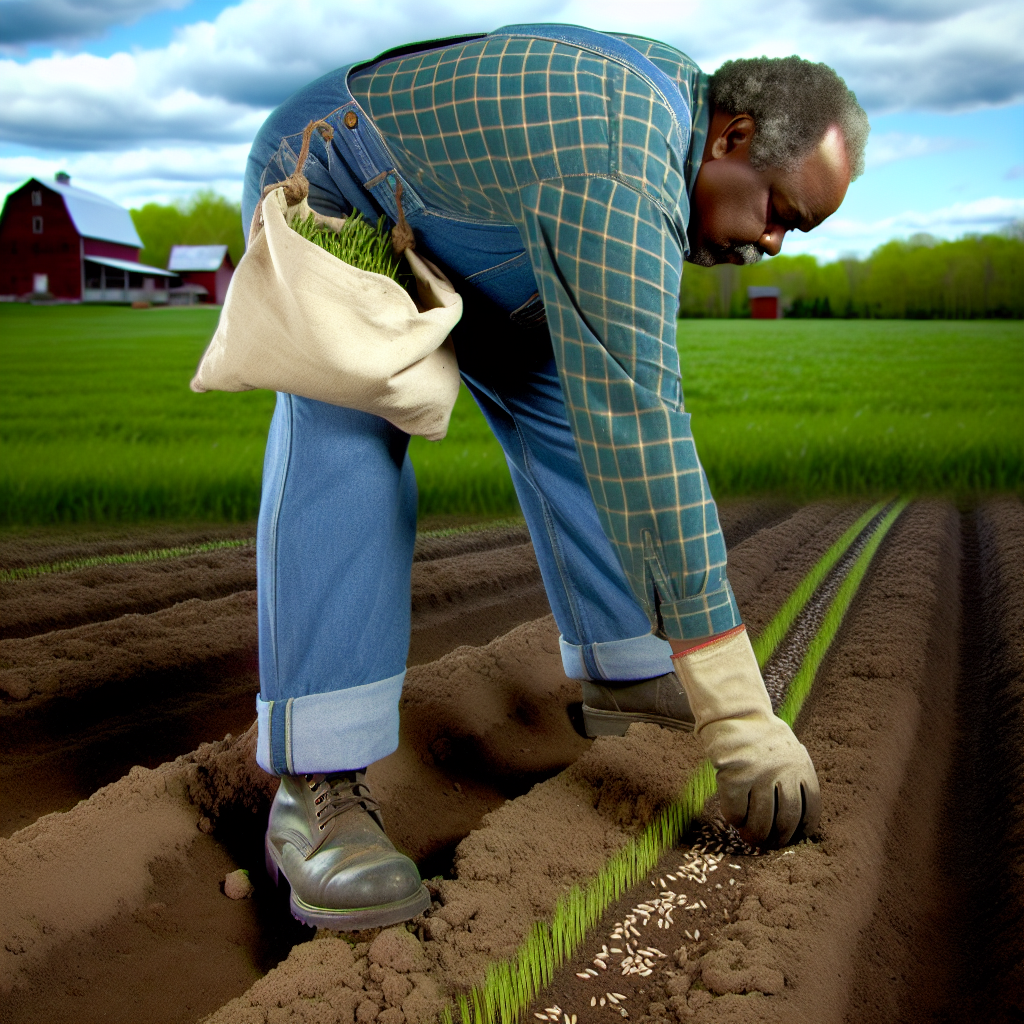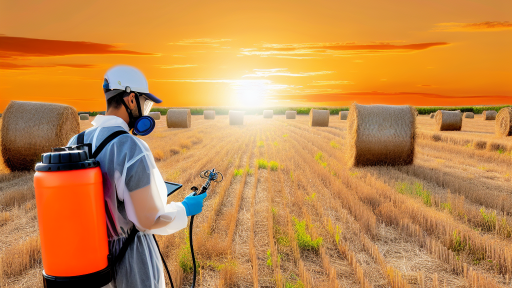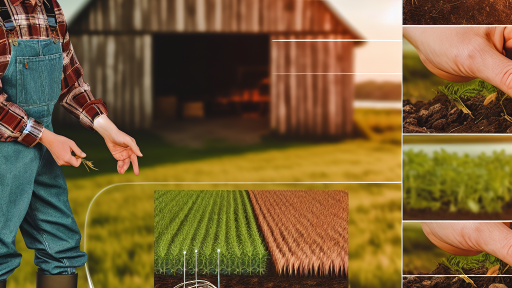Introduction to Cover Crops and Soil Fertility
Cover crops play a vital role in enhancing soil fertility.
Farmers use these crops to protect and enrich their land.
They prevent soil erosion and improve soil structure.
Furthermore, cover crops can boost organic matter content.
This results in healthier, more productive soils.
Benefits of Cover Crops
Cover crops offer several critical benefits.
Firstly, they enhance nutrient availability for future crops.
Leguminous cover crops, for example, fix atmospheric nitrogen.
Additionally, they suppress weeds effectively.
This suppression reduces competition for moisture and nutrients.
Improving Soil Health
Cover crops contribute to improved soil health.
They promote beneficial microbial activity in the soil.
Moreover, cover crops increase water infiltration and retention.
This capability helps reduce the risk of flooding.
Healthy soils are crucial for sustainable agriculture.
Transform Your Agribusiness
Unlock your farm's potential with expert advice tailored to your needs. Get actionable steps that drive real results.
Get StartedA Practical Strategy
Integrating cover crops into a cropping system is a smart choice.
Farmers can select specific cover crops based on local conditions.
This selection ensures optimal benefits for soil fertility.
Regularly incorporating cover crops can also enhance crop yields.
Benefits of Using Cover Crops in Agriculture
Enhancing Soil Fertility
Cover crops naturally improve soil fertility.
They add organic matter and nutrients to the soil.
This leads to healthier plant growth and increased yields.
Reducing Soil Erosion
Cover crops prevent soil erosion effectively.
Their roots bind the soil, reducing loss during heavy rains.
Additionally, they cover the surface, minimizing wind erosion.
Suppressing Weeds
They act as a natural weed suppressant.
Cover crops outcompete weeds for light and nutrients.
As a result, they reduce the need for herbicides.
Improving Soil Structure
Cover crops enhance soil structure significantly.
Their root systems create channels in the soil.
This improves water infiltration and aeration.
Benefitting Soil Microorganisms
These crops promote beneficial soil microorganisms.
They provide habitat and food for these organisms.
Consequently, soil health and fertility improve over time.
Enhancing Water Retention
Cover crops improve soil’s water retention capacity.
They help maintain moisture levels during dry periods.
This is crucial for sustainable agricultural practices.
Top Cover Crops for Enhancing Soil Fertility
Legumes for Nitrogen Fixation
Legumes are excellent cover crops that enhance soil fertility.
They fix atmospheric nitrogen into the soil, reducing the need for synthetic fertilizers.
Showcase Your Farming Business
Publish your professional farming services profile on our blog for a one-time fee of $200 and reach a dedicated audience of farmers and agribusiness owners.
Publish Your ProfileClover, vetch, and peas are popular choices for legume cover crops.
These crops improve soil structure and increase organic matter.
Additionally, they attract beneficial insects, promoting a healthy ecosystem.
Brassicas for Soil Health
Brassicas, such as radishes and mustard, provide unique benefits for soil health.
They can break up compacted soil with their deep roots.
Furthermore, brassicas suppress weeds and reduce soilborne diseases.
They are also known for their ability to scavenge residual nutrients.
This can help reduce nutrient runoff and enhance overall soil health.
Grasses for Erosion Control
Grasses serve as an effective barrier against soil erosion.
They stabilize the soil with their extensive root systems.
Common grass cover crops include rye, oats, and barley.
These crops improve soil aeration and water infiltration.
They also contribute to moisture retention, benefiting subsequent crops.
Mixing Cover Crops for Maximum Benefits
Mixing different cover crops maximizes benefits for soil fertility.
A diverse mix can target various soil health aspects.
For instance, combining legumes with grasses enhances nitrogen levels and erosion control.
This strategy promotes a robust root system and increases organic matter.
Additionally, mixed cover crops create a more resilient ecosystem.
Best Practices for Using Cover Crops
Implementing cover crops requires careful planning and management.
Choose cover crops that suit your local climate and soil type.
Timing of planting and termination is crucial for effectiveness.
It’s essential to terminate cover crops before they set seed.
Moreover, maintain proper nutrient management to complement cover crop benefits.
Learn More: Mulching for Pest Management in Crop Cultivation
Leguminous Cover Crops: Key Players in Nitrogen Fixation
Understanding Leguminous Cover Crops
Leguminous cover crops are vital for enhancing soil fertility.
They are known for their ability to fix atmospheric nitrogen.
This process enriches soil, improving nutrient availability for subsequent crops.
Common legumes include clover, vetch, and peas.
Benefits of Nitrogen Fixation
Nitrogen fixation reduces the need for synthetic fertilizers.
This practice lowers farming costs while enhancing sustainability.
Moreover, it helps minimize nitrogen leaching into waterways.
Healthy soil supports better crop yields and reduces environmental impact.
Popular Leguminous Cover Crops
- Crimson Clover: Excellent for early spring planting.
- Hairy Vetch: Adaptable and effective in various climates.
- Austrian Winter Pea: Great for cold climates, offering robust growth.
How to Incorporate Leguminous Cover Crops
Timing is crucial for successful cover crop establishment.
Plant legumes in fall for winter cover and spring growth.
Ensure proper termination to allow decomposition before planting main crops.
Consider crop rotation to maximize benefits from different leguminous species.
Explore Further: Benefits of Mulching for Soil Structure and Fertility
Non-Leguminous Cover Crops: Organic Matter and Soil Structure
Introduction to Non-Leguminous Cover Crops
Non-leguminous cover crops play a vital role in sustainable agriculture.
They enhance soil fertility by improving the organic matter content.
Moreover, they contribute to better soil structure over time.
Showcase Your Farming Business
Publish your professional farming services profile on our blog for a one-time fee of $200 and reach a dedicated audience of farmers and agribusiness owners.
Publish Your ProfileTypes of Non-Leguminous Cover Crops
A variety of non-leguminous cover crops exists for farmers to choose from.
Some common examples include rye, oats, and buckwheat.
Each of these crops has unique benefits and characteristics.
Improving Organic Matter
Non-leguminous cover crops effectively increase organic matter in the soil.
As they grow, they produce biomass through their leaves and stems.
When these plants decompose, they enrich the soil with nutrients.
This process enhances microbial activity and nutrient availability.
Enhancing Soil Structure
These cover crops also play a significant role in improving soil structure.
Their root systems create channels in the soil, promoting aeration.
Additionally, they help with water infiltration and reduce erosion.
Healthy soil structure improves root penetration for subsequent crops.
Reducing Compaction
Non-leguminous cover crops can combat soil compaction effectively.
Roots from these plants can break up compacted layers in the soil.
This results in improved drainage and better root growth.
Supporting Soil Microorganisms
These cover crops foster a diverse and active soil microbial community.
A robust microbial population contributes to nutrient cycling.
As a result, soil fertility increases naturally over time.
Benefits of Non-Leguminous Cover Crops
Non-leguminous cover crops are essential for soil health.
They provide numerous benefits to organic matter and soil structure.
Choosing the right cover crop can significantly enhance agricultural sustainability.
You Might Also Like: Crop Rotation Strategies for Healthy Soils
Choosing the Right Cover Crop for Your Region and Soil Type
Understanding Regional Climates
Your region’s climate significantly impacts cover crop performance.
Consider temperature, precipitation, and frost dates when selecting crops.
Sandy soils may require different cover crops than clay soils.
Moreover, local weather patterns can dictate which crops thrive best.
Identifying Soil Types
Each soil type offers unique characteristics that affect crop selection.
Loamy soils generally hold nutrients well and support diverse crops.
In contrast, sandy soils drain quickly but may require specialized cover crops.
Assessing soil pH can also guide your choices effectively.
Choosing Suitable Cover Crops
Selecting the ideal cover crop enhances soil fertility and structure.
Consider legumes, which can fix nitrogen and enrich the soil.
Brassicas can help break up hardpan soils and improve aeration.
Additionally, small grains can provide erosion control and ground cover.
Consulting Local Resources
Local agricultural extension services can provide valuable insights.
They often recommend specific crops suited for particular regions.
Furthermore, local farmer networks can share firsthand experiences.
Utilizing these resources can lead to more informed decisions.
You Might Also Like: Organic Solutions for Hydroponic Cultivation

Management Practices for Effective Cover Crop Usage
Choosing the Right Cover Crops
Selecting the appropriate cover crops is crucial for soil fertility.
Different crops serve various purposes, including nutrient cycling and improving soil structure.
Showcase Your Farming Business
Publish your professional farming services profile on our blog for a one-time fee of $200 and reach a dedicated audience of farmers and agribusiness owners.
Publish Your ProfileConsider factors like climate, soil type, and crop rotation when making your choice.
Timing Planting and Termination
Plant cover crops at the right time to maximize their benefits.
In general, sow them before the end of the growing season.
Terminate the cover crop before planting cash crops to avoid competition for nutrients.
Adjust your timeline based on local weather and crop schedules.
Incorporating Cover Crops into Crop Rotation
Integrate cover crops into your crop rotation plan for optimal soil health.
This practice helps break pest and disease cycles effectively.
Additionally, rotating cover crops enhances nutrient availability for subsequent cash crops.
Utilizing No-Till Practices
No-till methods work well with cover crops for better soil structure.
Leaving cover crops undisturbed retains moisture and organic matter in the soil.
Moreover, this practice protects soil from erosion and compaction.
Monitoring Soil Health Regularly
Regular soil testing helps assess the effectiveness of cover crops.
Keep track of changes in nutrient levels and soil structure.
This information can guide future management decisions.
Engaging with Local Experts
Consult agronomists or cooperative extension services for personalized advice.
They can provide insights tailored to your local conditions and needs.
Building relationships with local farmers also encourages knowledge sharing.
Case Studies: Successful Implementation of Cover Crops
Green River Farms
Green River Farms adopted cover crops to enrich their soil quality.
The farm focused on planting clover and vetch during the off-season.
This strategy significantly improved nitrogen levels in the soil.
Additionally, the cover crops reduced erosion and water runoff.
As a result, they noted a 30% increase in crop yields.
Lakeside Organic Co.
Lakeside Organic Co. implemented a diverse cover crop mix.
They utilized rye, legumes, and mustard to boost soil health.
This combination effectively suppressed weeds throughout the growing season.
Furthermore, it enhanced the overall biodiversity on their farm.
The management reported better soil structure and moisture retention.
Sunny Ridge Agricultural Solutions
Sunny Ridge Agricultural Solutions focused on educational outreach.
They held workshops to teach local farmers about cover crops.
Participants learned how to select the right crops for their fields.
This initiative encouraged community collaboration and knowledge sharing.
Consequently, many local farms successfully adopted cover cropping practices.
River Valley Produce
River Valley Produce experimented with planting winter cover crops.
They noticed improved soil fertility and reduced fertilizer reliance.
This approach not only saved costs but also increased environmental sustainability.
Farmers reported healthier plants and better pest resistance.
Such outcomes motivated other producers in the area to follow suit.
The Future of Cover Crops in Sustainable Farming
Enhancing Soil Health
Cover crops play a crucial role in enhancing soil health.
They prevent erosion by protecting the soil surface.
Furthermore, they improve soil structure and water retention.
Showcase Your Farming Business
Publish your professional farming services profile on our blog for a one-time fee of $200 and reach a dedicated audience of farmers and agribusiness owners.
Publish Your ProfileThese crops also promote beneficial microbial activity.
Boosting Nutrient Availability
Cover crops help in fixing atmospheric nitrogen in the soil.
Organic matter from decaying cover crops enriches soil fertility.
They can also scavenge nutrients and make them available for subsequent crops.
Supporting Biodiversity
Incorporating diverse cover crops fosters a rich ecosystem.
This diversity can attract pollinators and beneficial insects.
Additionally, it helps in disrupting pest cycles.
Adapting to Climate Change
Cover crops improve resilience against extreme weather patterns.
They can help retain moisture during dry spells.
Moreover, they reduce runoff during heavy rains, preventing soil degradation.
Economic Benefits
Farmers can reduce chemical fertilizer costs by using cover crops.
These crops can also lead to higher yields in subsequent cropping seasons.
Such practices can increase the overall profitability of sustainable farming.
Policy and Education Initiatives
Supporting policies can promote the use of cover crops among farmers.
Education programs can inform about the benefits and techniques of cover cropping.
Research and development can lead to improved crop varieties.
Cover crops are vital for sustainable farming’s future.
They improve soil fertility, support biodiversity, and adapt to climate challenges.
Farmers adopting cover cropping practices will benefit economically while contributing to environmental health.
Additional Resources
Managing Cover Crops Profitably, 3rd Edition – SARE
Managing Pests with Cover Crops – SARE




